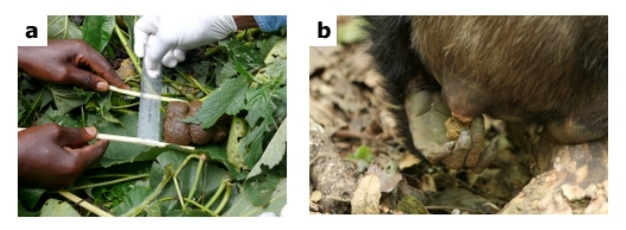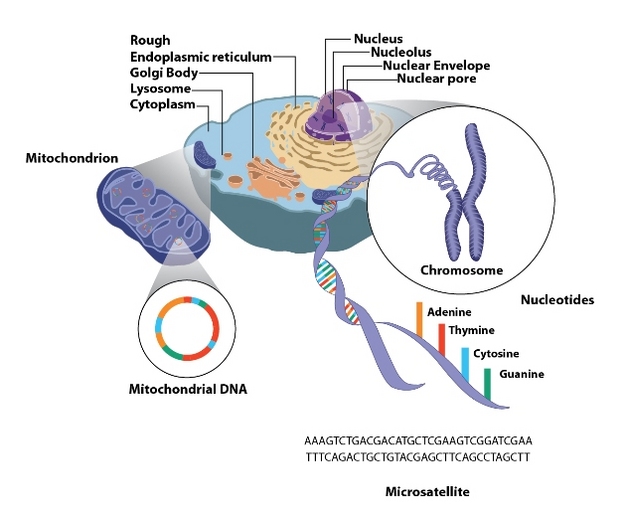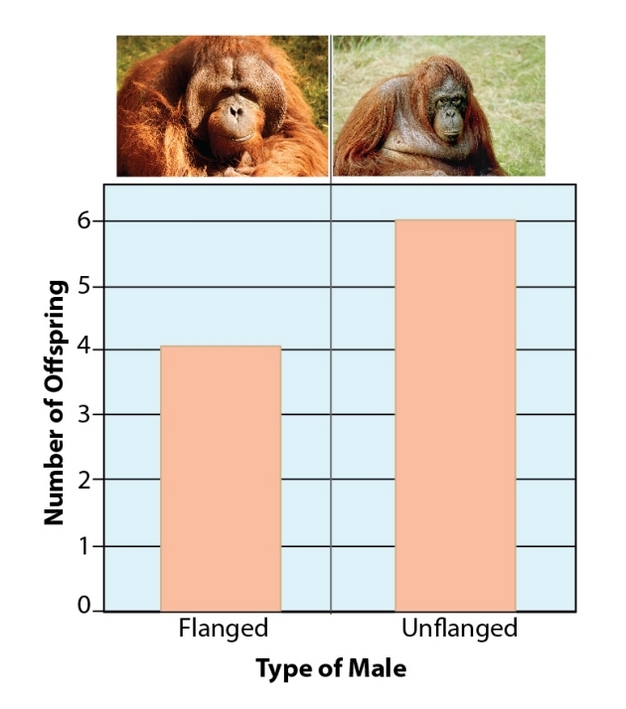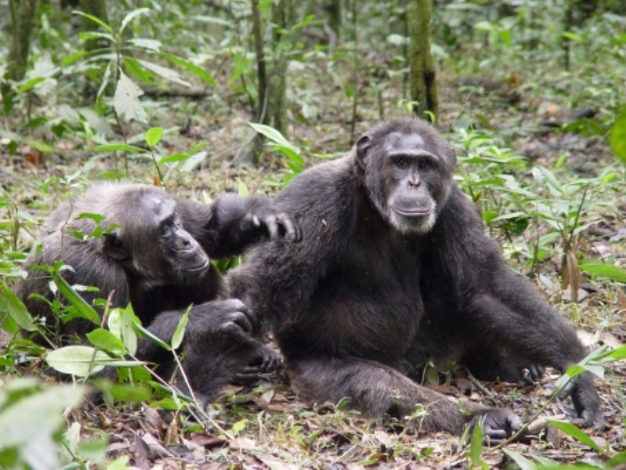« Prev Next »

Like many other social mammals, primates often live in stable groups containing individuals of both sexes and of various ages. While much information concerning the social relationships of individuals can be amassed by patient direct observation of members of wild groups habituated to human observation, genetic analysis can provide important insights into movement of individuals between groups, how successful individuals are at breeding, and how individuals are related to one another.
Noninvasive Sampling of Primates
Because many wild primates are endangered, elusive, or both, researchers have found creative ways to collect DNA from their study subjects without handling them. Like forensic scientists, primate researchers use shed hair, chewed fruit, and even feces for DNA analysis (Figure 1). Arboreal primates pose particular challenges, but may be sampled by plucking hair using sticky blow darts, or by collecting shed hairs in ape night nests. The DNA extracted from noninvasive samples tends to be low in quantity and quality, making it challenging — but not impossible — to use it to conduct reliable analyses (Taberlet et al. 1999).

Rapidly Evolving DNA Sequences are Most Useful
The members of one or several wild primate groups may be closely related, and so to tell individuals apart genetically it is usually best to analyze segments of DNA that mutate rapidly and are therefore highly variable. Microsatellite loci, which are particular segments in the nuclear genome containing different numbers of repeated elements, are relied upon in studies focusing on the determination of family relationships between individuals (Figure 2). Another very useful and highly variable piece of DNA is found in the mitochondria, the organelles outside the nucleus where energy for the cell is generated. Mitochondrial DNA (mtDNA) can often be easily isolated from low-quality and low-quantity samples, since each mitochondrion usually contains multiple mtDNA copies, and each cell — depending on organism and tissue type — can harbor many mitochondria. Because these mtDNAs are only passed down from mother to offspring, and thus directly track the history of the maternal line, many studies of dispersal patterns have employed mtDNA markers (Di Fiore 2003). Paternal genetic history and male movements can be tracked by analyses of microsatellite or DNA sequence variation on the Y-chromosome (Vigilant & Guschanski 2009).

Dispersal Patterns
Because mtDNA sequences reflect the history and relationships of females, if females are moving between social groups, we expect the mtDNA sequences found in those groups to be more similar than we would find if females do not disperse. If instead, males are moving between groups, very little differentiation of Y-chromosomes between groups is expected. Unfortunately, because the structure of Y-chromosome variation varies greatly among species, it is currently difficult to assess in most primates. Therefore, inferences on dispersal rely on examining mtDNA variation or microsatellite variation at autosomal loci inherited on the chromosomes from both parents.
Like the majority of group-living mammals, most primates exhibit female philopatry and male emigration (Greenwood 1980), although patterns in New World primates are less well investigated (Fernandez-Duque et al. 2012). In Old World monkeys, such as baboons or macaques, social groups thus contain one or more extended matrilines of females and a changing cast of immigrant adult males. In addition to mtDNA, female Old World monkeys also inherit their social rank from their mothers, so members of particular matrilines are socially dominant over all members of other matrilines. When groups of rhesus macaques become too large, group splits typically result in members of matrilines staying together, underlining the importance of social relations among philopatric female kin (Widdig et al. 2006).
In species in which both sexes disperse, interesting patterns can emerge when genetic data are analyzed separately for each sex. For example, although both sexes disperse in mountain gorillas, the resulting structure of genetic variation in the entire adult population is consistent with that observed in just females, while no structure is observed in the males (Guschanski et al. 2008). Furthermore, the female pattern tracks the altitude and types of vegetation available. These observations suggest that while males disperse throughout the population, females do not disperse as far, and are influenced in their dispersal decisions by the type of habitat available. So instead of just choosing a group containing congenial potential mates, dispersing primates — especially females who need to find sufficient food to raise offspring — may take ecological factors into account as well.
Social Behaviour and Paternity
It is particularly hard to infer patterns of reproduction from observational data in primates that are largely solitary, such as orangutans. Adult male orangutans can differ greatly in appearance, and large males sporting cheek flanges call and advertise their presence on their territories, while smaller unflanged males quietly roam the forest. Genetic analysis of paternity in a sample of 10 wild orangutan offspring found that both types of males are successful in producing offspring, and it is suspected that, while the large males are attractive to females, the small males can employ coercive mating tactics (Figure 3) (Utami et al. 2002).

Patterns of male social and reproductive dominance and dispersal are closely linked. If a male maintains social dominance for a long time, there is a risk of his producing offspring with his resident maturing daughters in the group. Accordingly, females commonly disperse in taxa — such as gorillas — in which the tenure of a dominant male normally exceeds the time needed for females to mature. In many other primate species, females can stay in their natal groups because male tenure is typically short. However, male tenure can vary greatly, and genetic analysis was used to show that even when a dominant white-handed capuchin male enjoys an unusually long spell of reproductive monopolization, he very rarely sires the offspring of his mature adult daughters (Muniz et al. 2006). The means by which inbreeding is avoided is puzzling, and raises the question of how primate individuals may recognize kin (Widdig 2007).
Social Relationships and Kin Preferences
Social relationships with members of the same sex are extraordinarily important for group-living primates. This has been particularly well demonstrated in baboons, where philopatric females with strong social bonds to other females —who are often matrilineal kin — live longer and produce more offspring (Silk et al. 2003). While it is easy to imagine that philopatric females become bonded with their sisters through their common relationship with the mother, it is less easy to understand how primates might recognize paternal kin. Nevertheless, studies in baboons and macaques have combined genetic determination of paternal relationships with observational data to suggest that females do indeed exhibit preferences for paternal kin, although not as strong as for maternal kin (Langergraber, 2012). In contrast, philopatric male chimpanzees exhibit no preference for social interactions with paternal brothers, and although they typically form strong social bonds with maternal brothers when available, the majority of social bonds are formed between unrelated individuals (Langergraber et al. 2007) (Figure 4).

Researchers have more recently turned attention to the nature of social bonds between members of the dispersing sex. While dispersing males are expected to compete fiercely for reproductive opportunities in their new groups, it was recently shown that unrelated Assamese macaque males that cooperated in coalitions were more likely to improve their rank and subsequently reproduce (Schülke et al. 2010). As expected, pairs of kin are exceedingly rare among post-dispersal female chimpanzees, but female chimpanzees nonetheless form enduring, highly differentiated social bonds with one another, again emphasizing the flexible nature of social bonding in our closest living relatives (Langergraber et al. 2009). Overall, a combination of genetic analysis and behavioural observation highlights that kin ties are important, but not necessary, for social bonding.
Future Directions
References and Recommended Reading
Di Fiore, A. Molecular genetic approaches to the study of primate behavior, social organization, and reproduction. American Journal of Physical Anthropology 122, 62-99 (2003).
Fernandez-Duque, E., Di Fiore, A., Huck, M. "The behavior, ecology and social evolution of New World monkeys," in The Evolution of Primate Societies, eds. J. Mitani et al. (Chicago, IL: University of Chicago Press, 2012).
Ellis, L. Dominance and reproductive success among nonhuman animals: A cross-species comparison. Ethology and Sociobiology 16, 257-333 (1995).
Greenwood, P. J. Mating systems, philopatry and dispersal in birds and mammals. Animal Behaviour 28, 1140-1162 (1980).
Guschanski K. et al. Females shape the genetic structure of a gorilla population. Current Biology 18, 1809-1814 (2008).
Kappeler, P. M. "The behavioral ecology of strepsirrhines and tarsiers," in The Evolution of Primate Societies, eds. J. Mitani et al. (Chicago, IL: University of Chicago Press, 2012).
Langergraber, K. E., Mitani, J. C. & Vigilant, L. The limited impact of kinship on cooperation in wild chimpanzees. Proceedings of the National Academy of Sciences of the United States of America 104, 7786-7790 (2007).
Langergraber, K. E. et al. Kinship and social bonds in female chimpanzees (Pan troglodytes). American Journal of Primatology 71, 1-12 (2009).
Langergraber, K. E. "Cooperation among kin," in The Evolution of Primate Societies, eds. J. Mitani et al. (Chicago, IL: University of Chicago Press, 2012).


































